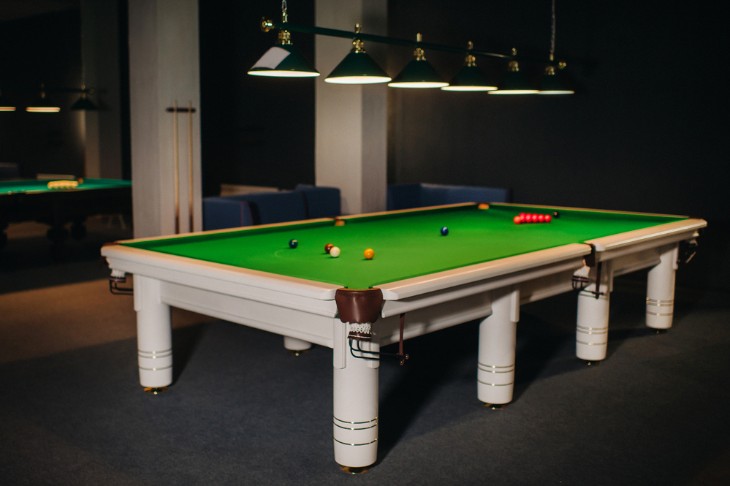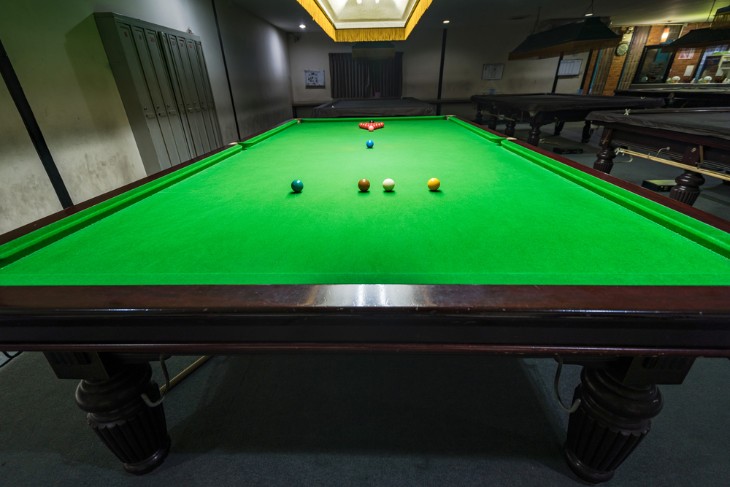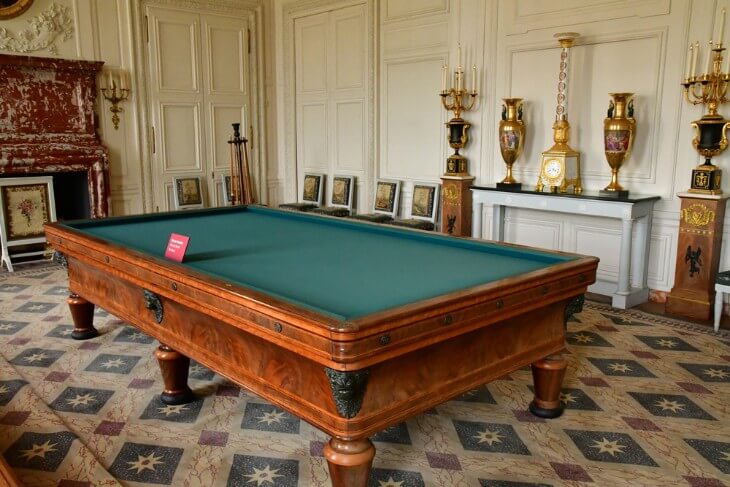The size varies from the large tables used in professional tournaments to the smaller ones found in recreational settings. Each size offers a different platform for players to demonstrate their abilities:
Dimensions of a Snooker Table
Length and Width Specifications:
- Full-Sized Snooker Table: The standard full-sized snooker table used in professional tournaments typically measures around 12 feet (365.76 cm) in length and 6 feet (182.88 cm) in width.
- Playing Surface: The playing surface within the cushions, where the balls are manoeuvred, usually measures about 11 feet 8.5 inches (356.9 cm) by 5 feet 10 inches (177.8 cm).
- Cushion Width: The cushions around the playing area are around 2.25 inches (5.715 cm) wide.
Variation in Sizes:
Tournament Tables vs. Recreational Tables:
- Tournament Tables: These adhere strictly to the standard measurements specified by official governing bodies like the WPBSA. The accuracy and consistency of these tables are crucial in professional play to ensure fairness across matches.
- Smaller Tables for Recreational Use: In contrast, smaller snooker tables are designed for recreational purposes, often found in bars, clubs, or home game rooms. These can vary significantly in size, commonly measuring around 6 feet (182.88 cm) or 7 feet (213.36 cm) in length and are notably narrower than professional tables.
Impact on Gameplay:
- Professional tables: The larger surface area of a standard snooker table demands more precise cue ball control and strategic planning due to the increased distance between balls. It accentuates the technical skills required for successful play.
- Recreational tables: Smaller tables, while offering a more compact playing space, can still provide a platform for casual gameplay but often require different strategies due to the reduced distance between balls. They might be more accessible for beginners or players with limited space.
Understanding these variations in sizes is vital for players, as each size demands different skill sets and strategies, impacting the overall gameplay experience. Professional players often practice on full-sized tables to hone their skills, while recreational players may find smaller tables more suitable for casual enjoyment.
The dimensions of a snooker table, whether standard or recreational, contribute significantly to the dynamics and challenges of the game, influencing players' approaches and skill development.

Components of a Snooker Table
Each component of a snooker table—the cloth/felt, cushions, and pockets—plays a pivotal role in shaping the game's dynamics. The quality, precision, and maintenance of these components contribute significantly to the overall playing experience, impacting ball movement, shot execution, and the level of challenge presented to players. Understanding the nuances of these elements allows players to adapt their strategies and refine their skills, adding depth to the game of snooker.
Cloth/Felt:
The cloth or felt covering the playing surface of a snooker table is one of its most critical components. Traditionally made from high-quality wool, the cloth is tightly woven to create a smooth and consistent surface. Its primary purpose is to provide a consistent and predictable playing surface for the balls to roll across. The cloth's thickness, known as the nap, affects the speed and behaviour of the balls. Professional-grade snooker tables use a fine-grade cloth that allows for precise ball control and enhances the game's skill-based nature. The cloth's maintenance, including regular brushing and ironing to ensure a level playing field, is crucial for maintaining optimal playing conditions.
Cushions:
The cushions, also referred to as the rails, encircle the playing surface of a snooker table. They are typically made from a resilient rubber compound, providing the necessary bounce and rebound for the balls. The cushions' precise construction is vital as they impact the ball's trajectory upon contact, affecting the angles and spin during gameplay. Properly maintained cushions are essential to ensure consistency in gameplay across the entire table. The width, height, and responsiveness of the cushions significantly influence a player's ability to execute shots, adding an element of technical challenge to the game.
Pockets:
Pockets are the openings located at the corners and along the rails of the snooker table. Their primary function is to collect the balls that are pocketed during gameplay. In professional settings, these pockets are designed to be exacting, with strict dimensions and precise angles. They are engineered to present a challenge to players, requiring accuracy and finesse in potting the balls. The snugness of the pockets is crucial—tighter pockets make the game more challenging by requiring more accuracy, while looser pockets can be more forgiving. Their placement and size are regulated in professional tournaments to maintain uniformity and fairness across different tables.
Standardization and Regulations
The stringent regulations set by governing bodies ensure that professional snooker maintains its integrity as a sport based on skill, strategy, and precision. The standardization of table specifications plays a pivotal role in upholding the competitive spirit and consistency expected in professional tournaments, shaping the experiences of both players and audiences.
Governing Bodies and Standardization:
The regulation and standardization of snooker tables are overseen by governing bodies such as the World Professional Billiards and Snooker Association (WPBSA). These bodies establish and enforce strict guidelines and specifications for snooker tables used in professional tournaments. The aim is to ensure consistency and fairness across all tournament venues, guaranteeing that players compete on tables of uniform quality and dimensions. This standardization is integral to maintaining the integrity of the game, as it minimizes variables that could impact the gameplay experience.
Specifications and Regulations:
The WPBSA specifies detailed regulations governing various aspects of snooker tables used in professional competitions. These regulations cover the dimensions and construction of the table, including requirements for the playing surface, cushion materials and dimensions, pocket size and placement, and even the cloth/felt quality. For instance, the cloth must meet specific standards regarding its composition and thickness to provide consistent gameplay conditions across different tournaments. Similarly, the pockets must conform to precise dimensions to present a consistent level of challenge to players.
Compliance with these regulations is mandatory for tournaments sanctioned by governing bodies. Tables undergo rigorous inspections to ensure they meet these exacting standards before play commences. This strict adherence to regulations helps maintain a level playing field for all competitors, emphasizing skill and strategy over external factors such as table variations.
Impact on Professional Play:
In professional snooker tournaments, adherence to standardized table specifications is paramount. Players train and strategize based on the expected conditions of tournament tables, including the consistent playing surface, cushion responsiveness, and pocket characteristics. The familiarity with these standardized features allows players to hone their skills and develop strategies tailored to the expected gameplay environment, enhancing the competitive nature of the sport.
Furthermore, standardized tables contribute to the prestige of professional tournaments, elevating the overall quality and legitimacy of the sport. Spectators and enthusiasts trust that the games are conducted under fair and regulated conditions, adding to the excitement and credibility of the event.
Variations in Snooker Table Sizes
Variations in snooker table sizes extend beyond the standardized dimensions used in professional tournaments. Recreational snooker tables, often found in bars, clubs, or personal game rooms, frequently deviate from the standard measurements. Smaller-sized tables, ranging from 6 feet to 7 feet in length, cater to individuals or venues where space is a constraint. These tables offer a more compact playing area while retaining the fundamental elements of the game. Despite the reduced size, these tables aim to replicate the essence of snooker, albeit with modifications to accommodate limited space. The narrower dimensions can affect gameplay dynamics, requiring players to adapt their strategies due to the closer proximity of balls and limited cue ball movement.
Impact on Gameplay and Skill Development:
The variations in table sizes significantly influence gameplay and skill development. Smaller tables demand adjustments in technique and shot selection compared to standard-sized tables. Players may experience a quicker pace of play and less complex positional play due to the shorter distances between balls. While these tables might be more accessible for casual players or beginners due to space constraints, they offer a different experience that challenges players to refine their precision and adaptability. Professional players often practice on full-sized tables to master the intricacies of the game, but playing on smaller tables can enhance cue ball control and encourage creative shot-making within a confined space. Ultimately, these variations in table sizes cater to diverse preferences and skill levels, offering alternatives for enjoying the game of snooker in various environments.

Importance of Knowing the Table Size
How big is a snooker table? The answer is much more than the numbers. Understanding the dimensions of a snooker table holds substantial importance for both players and enthusiasts, significantly impacting their experience and appreciation of the game. For players, familiarity with the table size directly influences their gameplay strategies, shot execution, and overall performance. A full comprehension of the standard dimensions of a snooker table allows players to develop specific techniques tailored to the table's size. For instance, on a full-sized table, players must navigate longer distances between balls, requiring precise cue ball control and strategic planning for positional play. Conversely, on smaller tables, the reduced space demands quicker decision-making and adaptation to the tighter confines, emphasizing accuracy in shot-making.
Moreover, for enthusiasts and viewers of the sport, knowledge of table sizes enhances their understanding and appreciation of player skills and gameplay dynamics. Awareness of how different table sizes influence the game allows spectators to recognize the complexities and challenges faced by players. It enables them to discern the nuances in strategies employed by players based on the table's dimensions during professional tournaments. This understanding fosters a deeper admiration for the skill, precision, and adaptability demonstrated by players across varied table sizes, enriching the overall spectator experience.
Ultimately, knowing the table size transcends mere technical information—it serves as a fundamental aspect that shapes the game's intricacies, affecting player strategies, skill development, and the audience's understanding and enjoyment of the sport. Whether it's for playing or spectating, acknowledging the impact of table size elevates one's engagement with the game of snooker.
Summary
The standard sizes used in professional tournaments and the various sizes for recreational use significantly influence the dynamics of snooker. Elements such as the table cloth, cushion quality, and pocket design are all critical components, each impacting the nature of gameplay and the development of player skills.
For more information:




.webp)


 (1).webp)




















